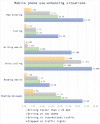"It's okay because I'm just driving": an exploration of self-reported mobile phone use among Mexican drivers
- PMID: 38410804
- PMCID: PMC10896083
- DOI: 10.7717/peerj.16899
"It's okay because I'm just driving": an exploration of self-reported mobile phone use among Mexican drivers
Abstract
Introduction: Technological advancements have the potential to enhance people's quality of life, but their misuse can have a detrimental impact on safety. A notable example is the escalating issue of distracted driving resulting from the use of mobile phones behind the wheel, leading to severe crashes and injuries. Despite these concerns, both drivers' usage patterns and their risk-related associations remain scarcely documented in Mexico. Therefore, this descriptive study aimed to examine the mobile phone usage of Mexican drivers, its relationships to risk awareness and near-miss/crash involvement, and the self-reported underlying reasons for this behavior.
Methods: This cross-sectional study utilized a sample of 1,353 licensed Mexican drivers who took part in a nationwide series of interviews regarding their onboard phone use settings.
Results: A significant percentage of drivers (96.8%) recognize using a mobile phone while driving as high-risk behavior. However, only 7.4% reported completely avoiding its use while driving, with 22.4% identified as high-frequency users. Frequency was also found positively associated with the self-reported rate of near-misses and crashes. Furthermore, qualitative data analysis highlights the emergence of a 'sense of urgency' to attend to phone-related tasks in response to daily demands and life dynamics, offering a potential explanation for this behavior.
Conclusion: The results of this study suggest common patterns of onboard mobile use among Mexican drivers concerning driving situations and associated risks. This underscores the need for increased efforts to discourage onboard phone use in the country.
Keywords: Cell phone; Driving; Habits; Road distractions; Texting.
©2024 Useche et al.
Conflict of interest statement
The authors declare there are no competing interests.
Figures




Similar articles
-
Effects of road infrastructure and traffic complexity in speed adaptation behaviour of distracted drivers.Accid Anal Prev. 2017 Apr;101:67-77. doi: 10.1016/j.aap.2017.01.018. Epub 2017 Feb 10. Accid Anal Prev. 2017. PMID: 28189943
-
Is it all about mobile phones? Exploring drivers' perceptions of government information and road rules on distracted driving.Accid Anal Prev. 2024 Dec;208:107770. doi: 10.1016/j.aap.2024.107770. Epub 2024 Sep 12. Accid Anal Prev. 2024. PMID: 39270506
-
A parametric duration model of the reaction times of drivers distracted by mobile phone conversations.Accid Anal Prev. 2014 Jan;62:42-53. doi: 10.1016/j.aap.2013.09.010. Epub 2013 Sep 21. Accid Anal Prev. 2014. PMID: 24129320
-
Is distraction on the road associated with maladaptive mobile phone use? A systematic review.Accid Anal Prev. 2023 Mar;181:106900. doi: 10.1016/j.aap.2022.106900. Epub 2022 Dec 27. Accid Anal Prev. 2023. PMID: 36580764
-
Cell phones and driving: review of research.Traffic Inj Prev. 2006 Jun;7(2):89-106. doi: 10.1080/15389580600651103. Traffic Inj Prev. 2006. PMID: 16854702 Review.
Cited by
-
Italian Adaptation of the No-Mobile-Phone-Phobia Questionnaire: Factorial Validity with the ESEM Technique and Population-Based Cut-Off Scores.Eur J Investig Health Psychol Educ. 2025 Aug 21;15(8):166. doi: 10.3390/ejihpe15080166. Eur J Investig Health Psychol Educ. 2025. PMID: 40863288 Free PMC article.
References
-
- Al-Jasser FS, Mohamed AG, Choudry A, Youssef RM. Mobile phone use while driving and the risk of collision: a study among preparatory year students at King Saud University, Riyadh, Saudi Arabia. Journal of Family and Community Medicine. 2018;25(2):102–107. doi: 10.4103/jfcm.JFCM_139_17. - DOI - PMC - PubMed
-
- Alghnam S, Towhari J, Alkelya M, Alsaif A, Alrowaily M, Alrabeeah F, Albabtain I. The association between mobile phone use and severe traffic injuries: a case-control study from Saudi Arabia. International Journal of Environmental Research and Public Health. 2019;16(15):2706. doi: 10.3390/ijerph16152706. - DOI - PMC - PubMed
-
- Amaya-Castellanos C. Individual and social behaviors: Strategies to maintain preventive actions in times of epidemic. Salud UIS. 2020;52(3) doi: 10.18273/revsal.v52n3-2020015. (In Spanish) - DOI
-
- Australian Transport Safety Bureau Community attitudes to road safety: community attitudes survey wave. 2005. https://www.infrastructure.gov.au/infrastructure-transport-vehicles/road... https://www.infrastructure.gov.au/infrastructure-transport-vehicles/road...
MeSH terms
LinkOut - more resources
Full Text Sources

